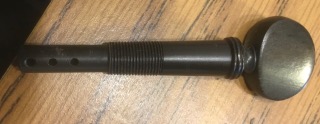
The tuners are very straightforward to fit and the peghed.com site has a detailed method . The pegs were primarily designed for use on Flamenco guitar which having a flat and regular peg area allows the instrument to be held in a drill press for the work.
The hurdy-gurdy can't be treated in the same way so rather than go for stepped concentric drills , I find it more accurate and less nerve wracking to drill pilot holes of 9mm. by eye and then open the holes up progressively with a tapered reamer . This allows accurate control of the depth of the peg in the pegbox.
Before fitting the pegs, it is important to make sure the string hole is large enough to take the designated string . Once glued in place, the pegs should be considered permanent and drilling out the hole will be difficult. The edges of the drilled out hole should be countersunk or filed smooth to avoid string damage as per the photo below:

The taper required is steeper than a standard cello reamer but one can be made very easily as follows :
Take an 11mm. twist drill, fit it in a drill press and run it at high speed. Taking a grinding wheel fitted in an electric drill, grind the tip of the drill down to 9mm.diam. Mark the drill shaft 35mm from the tip, this is the end of the taper so then simply stroke the wheel against the spinning drill until you have a straight line between the mark and the tip.
The reamer can be used in a slow speed electric drill but can also have a tommy bar hole drilled in the soft shank .

On new build or standard taper peg replacement , there should be no problem sinking the peg down to the required height. Once there, it can be made secure by applying a little wood glue to the threaded section and screwing it home. You will need to press the button down hard to stiffen the action of the peg while you screw it in. Once the glue is set, pull and twist the button to free off the mechanism.
It is possible on restoration projects that the existing peg hole is too large. A good way round this is to dampen some 0.6mm veneer and wrap it round the peg shaft with some wood glue. It may help to first wrap the veneer round the shaft of a small soldering iron ( not too hot ) in order to get it to curl round nicely. One thickness is usually plenty so then fit as before. If the old hole is badly oversized or damaged, I have found epoxy resin great . If you use "Araldite rapid", it is possible if necessary to remove the peg by heating the shaft with a soldering iron.
The pegs are designed to screw in clockwise so they tighten the string " a gauche". The tension of the string tends to stiffen the mechanism so little if any downward pressure is needed for general tuning purposes. The natural tendency to push the peg in when turning will make the mechanism uncomfortably stiff. . The pegs can be fitted the " wrong " way where it is required to tighten the string the other way. This usually occurs on the trompette and mouche strings where the builder has led them into the pegbox at the same positions as the bourdons. The pegs, in my opinion, work even better this way as the tension of the string is tending to loosen the mechanism but it feels natural to push the peg in slightly when tuning so the two effects cancel out